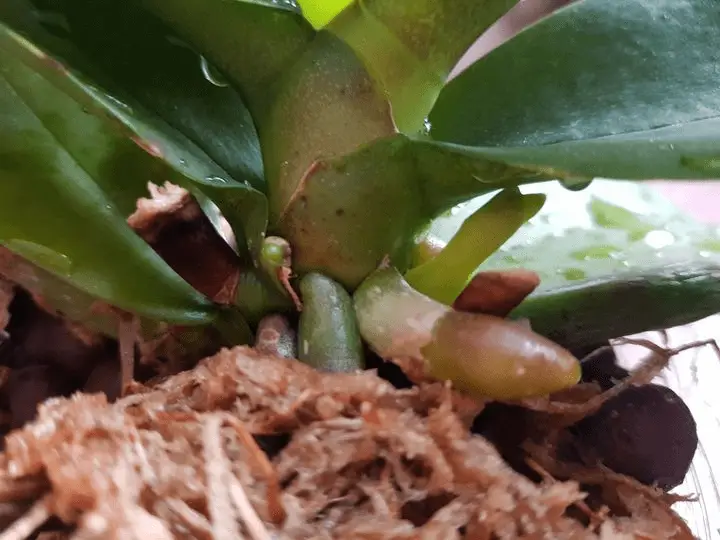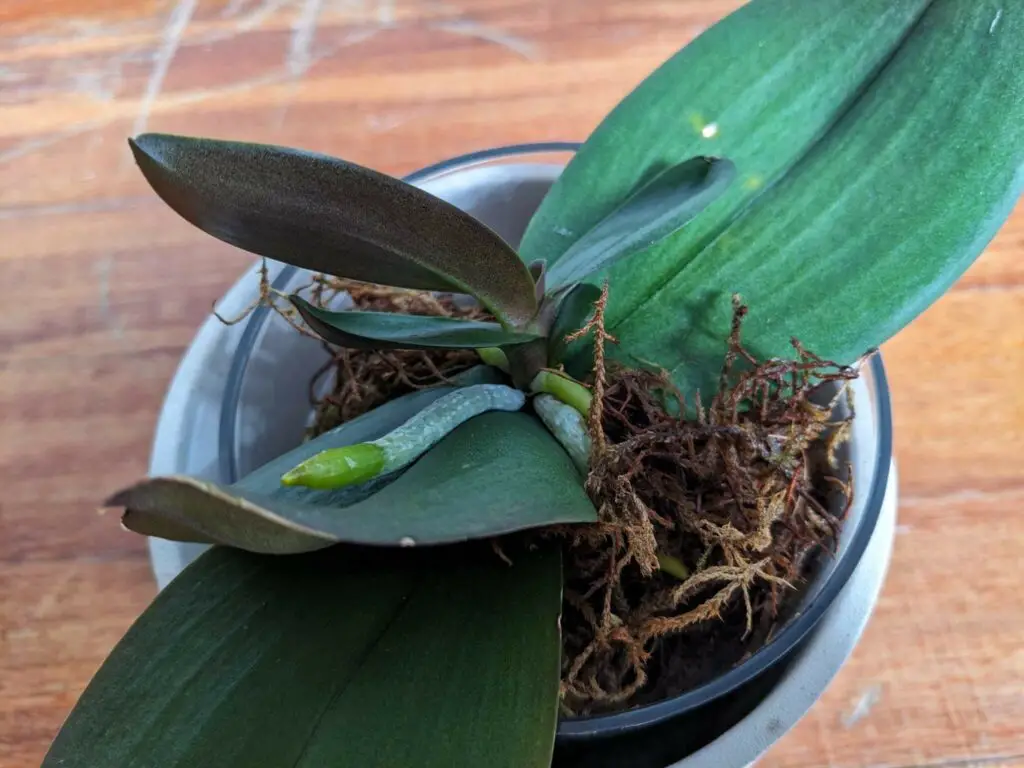If you are expecting an orchid to bloom, each tiny growth at the base of the stem can give you hope. Is this the flower spike you are waiting for? Or are they just roots?
Over time, I learned to spot the real deal—a true flower spike!
In this article, I will show you 5 major differences between an orchid root and a flower spike.
Key Takeaways
- Spikes have sharp, “mitten-shaped” tips, while root tips are blunt.
- Spikes maintain a green color throughout their entire length, while roots are silvery-gray with a green tip.
- Spikes originate from the node where the stem and leaf join, while roots can sprout randomly from leaf nodes or directly from the stem.
- Spikes typically appear during seasonal changes, while roots grow at any time.
- Spikes grow towards light, while roots wander in search of moisture and stability.
Appearance
When flower spikes emerge, they can be easily recognized by their sharp tips. On the other hand, root tips are blunt and not as sharp as emerging flower spikes.
As the spikes and roots grow, flower spikes can be more easily recognized by their mitten shape. They are also slimmer than roots.

Color
Flower spikes are green throughout the entire stem. They may have a reddish-brown hue when the flowers exhibit vibrant colors.
Roots first emerge as green tips, but as they develop, they show a silvery grayish coating called velamen that turns green when hydrated.

If you are unsure, take pictures of new sprouts and check back after about 10 days to determine their true nature.
Location
Another way to identify whether new growth is a spike or a root in orchids is to consider their location on the plant:
- Stem and leaf junction: The location where the stem and leaf meet is a crucial reference point. Spikes are nestled between leaves at this junction, while roots can appear anywhere on the stem, front or back, without any specific leaf association.
- Leaf association: Spikes are closely associated with the leaves, emerging in conjunction with them and following their upward trajectory. Roots, on the other hand, can grow independently of the leaves, appearing in random locations on the stem.
Seasonal Timing
Apart from the shape and location, consider when the flower stems appear.
Winter-blooming orchids like Phalaenopsis start to produce flower spikes in the fall when the days shorten and the temperature cools. Giving an orchid a drop in temperature is one of the techniques to make an orchid bloom.
On the other hand, roots grow anytime, especially during spring and summer, when the orchid requires more water and nutrients. The emergence of roots can be influenced by factors such as repotting or increased summer feeding.
Direction of Growth
The growth patterns of your orchid will also help determine the direction in which its spikes and roots emerge. Here are some key points to consider:
- Influence of light: Flower spikes exhibit directional growth towards light. They angle upwards, seeking light to ensure that the blooms are positioned for optimal display and exposure to sunlight.
- Rambling roots: Unlike spikes, roots lack a specific direction preference. Emerging roots may wander outward or sideways from the mother plant, making bends and turns as they search for moisture, air pockets, fertilizer, or support. Normally, many orchids produce many air roots that may stay out of the pot.
Understanding the purpose behind the growth patterns of your orchid will allow you to determine whether a new emergence is a flower spike or a root. By observing the direction in which they grow, you can gain insight into their function and better care for your orchid.
Frequently Asked Questions
Can Orchid Spikes and Roots Be Easily Distinguished by Their Size and Shape?
Orchid spikes and roots can be easily distinguished by their size and shape. Differences in characteristics, growth patterns, and visual cues make identification straightforward.
What Is the Significance of the Color Variation in Orchid Roots?
The color variation in orchid roots is significant because it indicates their health and function. Thinner outer cells absorb water and minerals, while inner layers store reserves. The transition from green to grayish-silver shows water absorption and root growth.
Do Orchid Spikes Always Grow Upwards Towards Light?
Orchid spikes generally grow upwards towards light due to their phototropic nature. Factors like light availability and plant genetics influence their direction. Mistaking spikes for roots can happen, but understanding growth patterns and observing their location can help distinguish between the two. To promote healthy spike growth, ensure adequate light and provide proper care.
Can Orchid Roots Grow Randomly in Any Direction?
Orchid roots can grow randomly in any direction, influenced by factors such as moisture, air pockets, and fertilizer seepage.
Are There Any Environmental Factors That Trigger the Growth of Orchid Spikes?
A change in temperature and light duration are crucial factors that trigger the production of orchid spikes.
- Top 6 Drip Irrigation Systems for Raised Beds (2025) - January 31, 2025
- Top 10 Orchid Fertilizers: A Comprehensive Review (2025) - January 16, 2025
- Top 6 Slow-Release Fertilizers for Houseplants & Veggies (2025) - January 15, 2025
